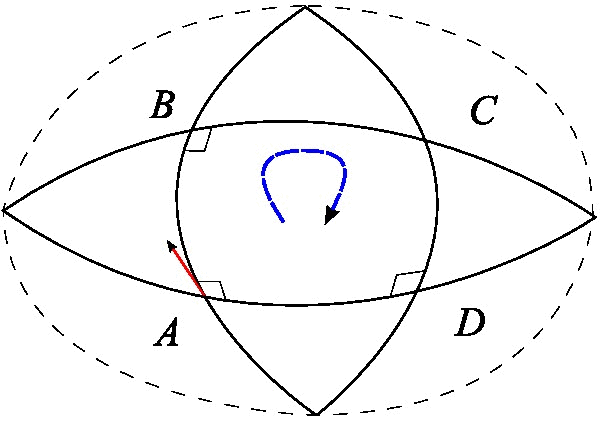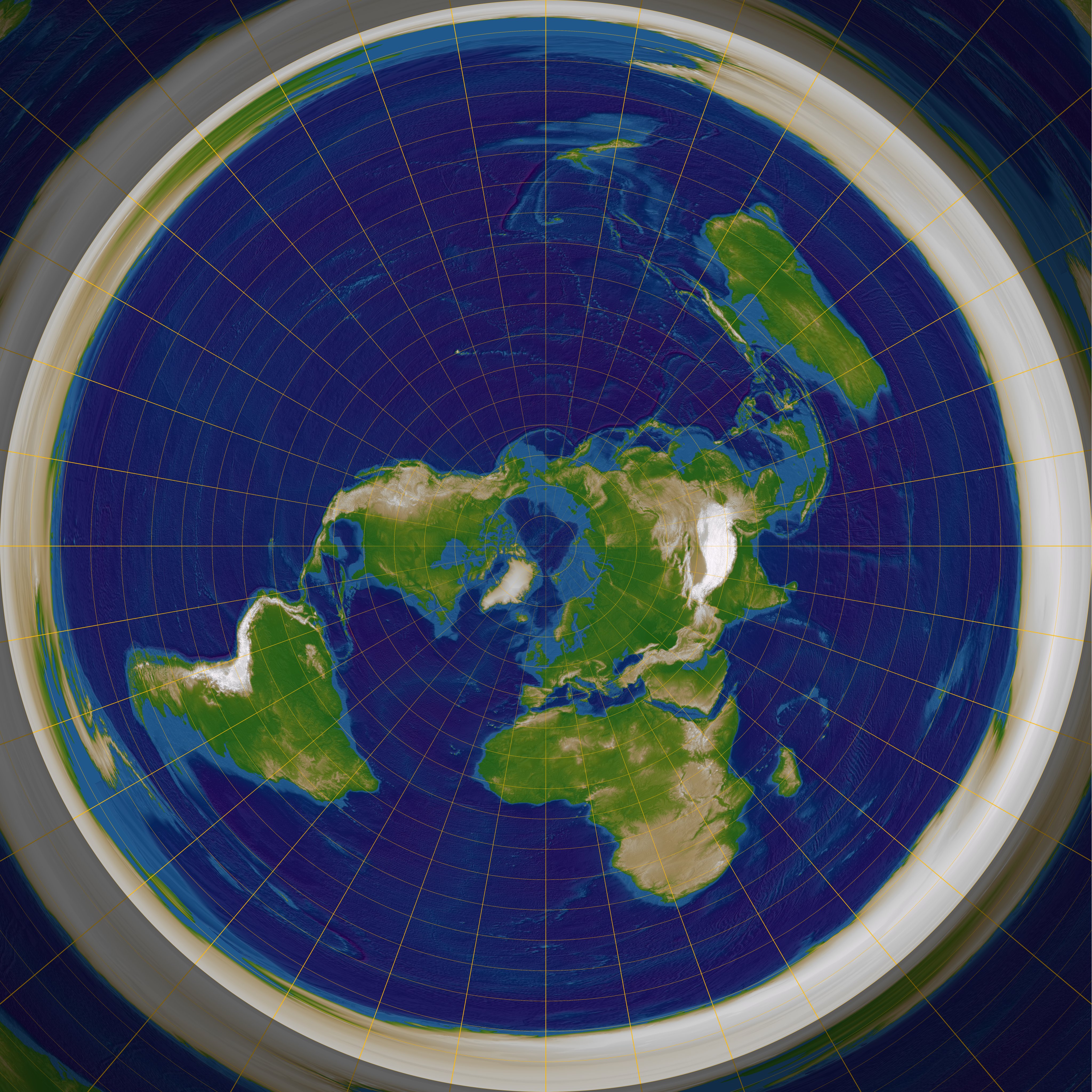|
Levi-Civita Parallelogramoid
In the mathematical field of differential geometry, the Levi-Civita parallelogramoid is a quadrilateral in a curved space whose construction generalizes that of a parallelogram in the Euclidean plane. It is named for its discoverer, Tullio Levi-Civita. Like a parallelogram, two opposite sides ''AA''′ and ''BB''′ of a parallelogramoid are parallel (via parallel transport side ''AB'') and the same length as each other, but the fourth side ''A''′''B''′ will not in general be parallel to or the same length as the side ''AB,'' although it will be straight (a geodesic).In the article by Levi-Civita (1917, p. 199), the segments AB and A'B ′ are called (respectively) the '' base'' and ''suprabase'' of the parallelogramoid in question. Construction A parallelogram in Euclidean geometry can be constructed as follows: * Start with a straight line segment ''AB'' and another straight line segment ''AA''′. * Slide the segment ''AA''′ along ''AB'' to the ... [...More Info...] [...Related Items...] OR: [Wikipedia] [Google] [Baidu] |
Neighborhood (mathematics)
In topology and related areas of mathematics, a neighbourhood (or neighborhood) is one of the basic concepts in a topological space. It is closely related to the concepts of open set and interior. Intuitively speaking, a neighbourhood of a point is a set of points containing that point where one can move some amount in any direction away from that point without leaving the set. Definitions Neighbourhood of a point If X is a topological space and p is a point in X, then a of p is a subset V of X that includes an open set U containing p, p \in U \subseteq V \subseteq X. This is also equivalent to the point p \in X belonging to the topological interior of V in X. The neighbourhood V need be an open subset X, but when V is open in X then it is called an . Some authors have been known to require neighbourhoods to be open, so it is important to note conventions. A set that is a neighbourhood of each of its points is open since it can be expressed as the union of open sets ... [...More Info...] [...Related Items...] OR: [Wikipedia] [Google] [Baidu] |
Curvature (mathematics)
In mathematics, curvature is any of several strongly related concepts in geometry. Intuitively, the curvature is the amount by which a curve deviates from being a straight line, or a surface deviates from being a plane. For curves, the canonical example is that of a circle, which has a curvature equal to the reciprocal of its radius. Smaller circles bend more sharply, and hence have higher curvature. The curvature ''at a point'' of a differentiable curve is the curvature of its osculating circle, that is the circle that best approximates the curve near this point. The curvature of a straight line is zero. In contrast to the tangent, which is a vector quantity, the curvature at a point is typically a scalar quantity, that is, it is expressed by a single real number. For surfaces (and, more generally for higher-dimensional manifolds), that are embedded in a Euclidean space, the concept of curvature is more complex, as it depends on the choice of a direction on the surface or ... [...More Info...] [...Related Items...] OR: [Wikipedia] [Google] [Baidu] |
Schild's Ladder
In the theory of general relativity, and differential geometry more generally, Schild's ladder is a First-order approximation, first-order method for ''approximating'' parallel transport of a vector along a curve using only Torsion of connection#Geodesics and the absorption of torsion, affinely parametrized geodesics. The method is named for Alfred Schild, who introduced the method during lectures at Princeton University. Construction The idea is to identify a tangent vector ''x'' at a point A_0 with a geodesic segment of unit length A_0X_0, and to construct an approximate parallelogram with approximately parallel sides A_0X_0 and A_1X_1 as an approximation of the Levi-Civita parallelogramoid; the new segment A_1X_1 thus corresponds to an approximately parallel translated tangent vector at A_1. Formally, consider a curve γ through a point ''A''0 in a Riemannian manifold ''M'', and let ''x'' be a tangent vector at ''A''0. Then ''x'' can be identified with a geodesic s ... [...More Info...] [...Related Items...] OR: [Wikipedia] [Google] [Baidu] |
Parallel Transport
In geometry, parallel transport (or parallel translation) is a way of transporting geometrical data along smooth curves in a manifold. If the manifold is equipped with an affine connection (a covariant derivative or connection (vector bundle), connection on the tangent bundle), then this connection allows one to transport vectors of the manifold along curves so that they stay ''parallel'' with respect to the connection. The parallel transport for a connection thus supplies a way of, in some sense, moving the local geometry of a manifold along a curve: that is, of ''connecting'' the geometries of nearby points. There may be many notions of parallel transport available, but a specification of one — one way of connecting up the geometries of points on a curve — is tantamount to providing a ''connection''. In fact, the usual notion of connection is the infinitesimal analog of parallel transport. Or, ''vice versa'', parallel transport is the local realization of a conne ... [...More Info...] [...Related Items...] OR: [Wikipedia] [Google] [Baidu] |
Riemann Curvature Tensor
In the mathematical field of differential geometry, the Riemann curvature tensor or Riemann–Christoffel tensor (after Bernhard Riemann and Elwin Bruno Christoffel) is the most common way used to express the curvature of Riemannian manifolds. It assigns a tensor to each point of a Riemannian manifold (i.e., it is a tensor field). It is a local invariant of Riemannian metrics which measures the failure of the second covariant derivatives to commute. A Riemannian manifold has zero curvature if and only if it is ''flat'', i.e. locally isometric to the Euclidean space. The curvature tensor can also be defined for any pseudo-Riemannian manifold, or indeed any manifold equipped with an affine connection. It is a central mathematical tool in the theory of general relativity, the modern theory of gravity, and the curvature of spacetime is in principle observable via the geodesic deviation equation. The curvature tensor represents the tidal force experienced by a rigid body moving al ... [...More Info...] [...Related Items...] OR: [Wikipedia] [Google] [Baidu] |
Exponential Map (Riemannian Geometry)
In Riemannian geometry, an exponential map is a map from a subset of a tangent space T''p''''M'' of a Riemannian manifold (or pseudo-Riemannian manifold) ''M'' to ''M'' itself. The (pseudo) Riemannian metric determines a canonical affine connection, and the exponential map of the (pseudo) Riemannian manifold is given by the exponential map of this connection. Definition Let be a differentiable manifold and a point of . An affine connection on allows one to define the notion of a straight line through the point .A source for this section is , which uses the term "linear connection" where we use "affine connection" instead. Let be a tangent vector to the manifold at . Then there is a unique geodesic satisfying with initial tangent vector . The corresponding exponential map is defined by . In general, the exponential map is only ''locally defined'', that is, it only takes a small neighborhood of the origin at , to a neighborhood of in the manifold. This is because it ... [...More Info...] [...Related Items...] OR: [Wikipedia] [Google] [Baidu] |
Tangent Vector
In mathematics, a tangent vector is a vector that is tangent to a curve or surface at a given point. Tangent vectors are described in the differential geometry of curves in the context of curves in R''n''. More generally, tangent vectors are elements of a tangent space of a differentiable manifold. Tangent vectors can also be described in terms of germs. Formally, a tangent vector at the point x is a linear derivation of the algebra defined by the set of germs at x. Motivation Before proceeding to a general definition of the tangent vector, we discuss its use in calculus and its tensor properties. Calculus Let \mathbf(t) be a parametric smooth curve. The tangent vector is given by \mathbf'(t), where we have used a prime instead of the usual dot to indicate differentiation with respect to parameter . The unit tangent vector is given by \mathbf(t) = \frac\,. Example Given the curve \mathbf(t) = \left\ in \R^3, the unit tangent vector at t = 0 is given by \mathbf(0) = \frac = ... [...More Info...] [...Related Items...] OR: [Wikipedia] [Google] [Baidu] |
Affine Parameter
In geometry, a geodesic () is a curve representing in some sense the shortest path ( arc) between two points in a surface, or more generally in a Riemannian manifold. The term also has meaning in any differentiable manifold with a connection. It is a generalization of the notion of a "straight line". The noun '' geodesic'' and the adjective ''geodetic'' come from '' geodesy'', the science of measuring the size and shape of Earth, though many of the underlying principles can be applied to any ellipsoidal geometry. In the original sense, a geodesic was the shortest route between two points on the Earth's surface. For a spherical Earth, it is a segment of a great circle (see also great-circle distance). The term has since been generalized to more abstract mathematical spaces; for example, in graph theory, one might consider a geodesic between two vertices/nodes of a graph. In a Riemannian manifold or submanifold, geodesics are characterised by the property of having vani ... [...More Info...] [...Related Items...] OR: [Wikipedia] [Google] [Baidu] |
Complete Space
In mathematical analysis, a metric space is called complete (or a Cauchy space) if every Cauchy sequence of points in has a limit that is also in . Intuitively, a space is complete if there are no "points missing" from it (inside or at the boundary). For instance, the set of rational numbers is not complete, because e.g. \sqrt is "missing" from it, even though one can construct a Cauchy sequence of rational numbers that converges to it (see further examples below). It is always possible to "fill all the holes", leading to the ''completion'' of a given space, as explained below. Definition Cauchy sequence A sequence x_1, x_2, x_3, \ldots in a metric space (X, d) is called Cauchy if for every positive real number r > 0 there is a positive integer N such that for all positive integers m, n > N, d\left(x_m, x_n\right) < r. Complete space A metric space is complete if any of the following equivalent conditions are satisfied: :#Every |

